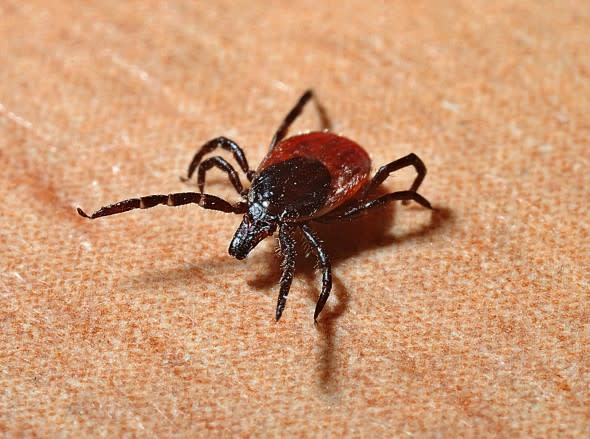Invasive East Asian tick recently found in US more likely to harm livestock than humans
An invasive species of tick native to East Asia, New Zealand and Australia has somehow made its way to the northeastern United States, both puzzling and concerning researchers.
A Hunterdon County, New Jersey, resident discovered multiple Haemaphysalis longicornis ticks, commonly referred to as long-horned or bush ticks, as she sheared her sheep in August 2017, NPR reported.
She noticed ticks on her arms during the process and informed county health officials. What she didn't realize was that larval-stage ticks as tiny as specks of dirt had gotten all over her clothing, according to reports.
In October, health officials visited her tick-infested paddock, where they said their clothing was swarmed with ticks within two minutes. More than 1,000 ticks were found in the 1-acre paddock, and the sheep was infested with hundreds of them.

Experts recommend taking precautions against ticks this season, including deer ticks, which can spread Lyme disease. (Image/Pixabay)
The tick survived winter, and as of late April, the New Jersey Department of Agriculture has confirmed its presence in Union County, about 40 miles away from where it was initially discovered. The tick has also been spotted in Middlesex County, New Jersey, and Albemarle County, Virginia.
"Anytime there's something out of the norm that we don't know, then we get a little panicked," said Dr. Thomas Mather, tick expert and professor of entomology at the University of Rhode Island. "Certainly, there is need for watchfulness in this case."
Although the ticks have been known to reportedly carry the potentially deadly virus that causes thrombocytopenia syndrome, which initially emerged in China in 2009, Hunterdon County health officials aren't worried that the long-horned tick will pose a threat to locals.
"Our concern at the moment is that this tick would become a problem to livestock and wildlife," said Tadhgh Rainey, division head of the Hunterdon County Health Department in a recent Facebook Live broadcast. Health officials continue to work with the U.S. Department of Agriculture and the Centers for Disease Control and Prevention to determine potential health threats. The ticks found in New Jersey appeared not to carry pathogens.
"If your children are out playing in the yard, or if you're out gardening, there's a very remote chance that you're ever going to see a long-horned tick," Rainey said.
Experts still recommend taking precautions against tick bites this time of year to prevent contracting illnesses such as Lyme disease, which is spread by deer ticks.
How ticks survive winter
Ticks' ability to make it through winter depends on the species and what life-cycle stage they're in when the low temperatures hit, according to Dr. Nancy Troyano, entomologist and director of technical education and training for pest control company Rentokil Steritech. Rentokil Steritech's regional brands include Western Exterminator, Presto-X and Ehrlich.
This particular species is known for its ability to survive harsh winters, according to Troyano. "Many tick species will wait out the cold under leaf litter or in the soil, and they'll be well insulated from the snow and freezing [conditions]," she said.
The ticks then go into a state of dormancy, called diapause, and in order to prepare for it, ticks will rid themselves of the water from their last blood meal.
This prevents the water from crystallizing inside of them in low temperatures, Troyano explained, adding that some ticks have antifreeze proteins which also keep them from freezing during winter.
"Other tick species will latch onto a mammalian host for the winter, which will keep them warm, and some species will survive the winter in the egg stage, hatching in the springtime when the temperatures rise," she said.
The long-horned tick, which is the most widespread tick species on wild and domestic animals in Japan, was previously unknown to the United States, raising the big question of how the tick arrived in the first place.
Although research shows that the tick had previously been found in the U.S. on large quarantined animals during the 1960s, the recent discovery marks the first time that all life stages - larvae, nymphs and adults - have been found on a U.S.- based, non-quarantined animal, according to NPR.
"It is currently unknown exactly how this tick wound up here," Troyano said of the mystery. "The particular sheep [on which the ticks were found] is the only animal on the property and had not left the property for many years."
The long-horned tick possesses the unique ability to reproduce via parthenogenesis, which means it doesn't need a male to lay viable eggs, Mather said.
"If there's a very low rate of ticks in an area, they have to find each other in order to lay fertile offspring, so that is kind of a barrier to a new introduction," he said. "But that doesn't have to be the case [with this tick]."
It's a characteristic that makes the invasive tick particularly problematic, according to Troyano. "They are prolific, with each female capable of laying between 800 to 2,000 eggs," she said.
Rainey noted that the tick has likely inhabited the U.S. for some time, working its way around on farm animals or wildlife.
The New Jersey Department of Agriculture has urged farmers to monitor livestock for the long-horned tick's presence and to look out for decreased growth rates and signs of anemia.
